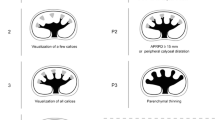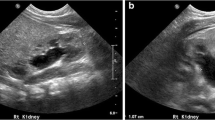Abstract
Purpose
The most common measurements of hydronephrosis are the anterior–posterior (AP) diameter and the Society for Fetal Urology (SFU) grading systems. To date, the inter-rater reliability (IRR) of these measures has not been compared in the postnatal period. The objectives of this study were to compare the IRR of the AP diameter and the SFU grading system in infants and to determine whether ultrasound findings other than pelvicalyceal dilation are associated with higher SFU grades.
Methods
Initial postnatal ultrasounds of infants seen from February 1, 2011, to January 31, 2012, with a primary diagnosis of congenital hydronephrosis were included for review. Ultrasound images were de-identified and reviewed by four pediatric urologists. IRR was calculated using the intraclass correlation (ICC) measure. A paired t test was used to compare ICCs. Associations between SFU grade and other ultrasound findings were tested using Chi-square or Fisher’s exact tests.
Results
A total of 112 kidneys in 56 patients were reviewed. IRR of the SFU grading system was high (right kidney ICC = 0.83, left kidney ICC = 0.85); however, IRR of AP diameter measurement was higher (right kidney ICC = 00.97, left kidney ICC = 0.98; p < 0.001). Renal asymmetry (p < 0.001), echogenicity (p < 0.001), and parenchymal thinning (p < 0.001) were significantly associated with SFU grade 4 hydronephrosis on bivariable and multivariable analysis.
Conclusions
The SFU grading system is associated with excellent IRR, although the AP diameter appears to have higher IRR. Physicians may consider ultrasound findings that are not explicitly included in the SFU system when assigning hydronephrosis grade, which may lead to variability in use of this classification system.

Similar content being viewed by others
References
Nguyen HT et al (2010) The Society for Fetal Urology consensus statement on the evaluation and management of antenatal hydronephrosis. J Pediatr Urol 6(3):212–231
Passerotti CC et al (2011) The predictive value of the first postnatal ultrasound in children with antenatal hydronephrosis. J Pediatr Urol 7(2):128–136
Elder JS (1997) Antenatal hydronephrosis. Fetal and neonatal management. Pediatr Clin N Am 44(5):1299–1321
Johnson CE et al (1992) The accuracy of antenatal ultrasonography in identifying renal abnormalities. Am J Dis Child 146(10):1181–1184
Fernbach SK, Maizels M, Conway JJ (1992) Ultrasound grading of hydronephrosis: introduction to the system used by the society for fetal urology. Pediatr Radiol 23:478
Pereira AK et al (2011) Antenatal ultrasonographic anteroposterior renal pelvis diameter measurement: is it a reliable way of defining fetal hydronephrosis? Obstet Gynecol Int 2011:861865
Keays MA et al (2008) Reliability assessment of Society for Fetal Urology ultrasound grading system for hydronephrosis. J Urol 180(4 Suppl):1680–1682 (discussion1682-3)
Compute 6 intraclass correlation measures. SAS. 2000. http://support.sas.com/kb/25/031.html. Accessed 8 Oct 2014
Maclure M, Willett WC (1987) Misinterpretation and misuse of the kappa statistic. Am J Epidemiol 126(2):161–169
Shrout PE, Fleiss JL (1979) Intraclass Correlations: uses in assessing rater reliability. Psychol Bull 86(2):420–428
Dhillon HK (1998) Prenatally diagnosed hydronephrosis: the Great Ormond Street experience. Br J Urol 81(Suppl. 2):39–44
Efron B, Tibshirani RJ (1993) An introduction to the bootstrap. Chapman & Hall/CRC, New York
Cicchetti DV (1994) Guidelines, criteria, and rules of thumb for evaluating normed and standardized assessment instruments in psychology. Psychol Assess 6(4):284–290
Dremsek PA et al (1997) Renal pyelectasis in fetuses and neonates: diagnostic value of renal pelvis diameter in pre-and postnatal sonographic screening. AJR Am J Roentgenol 168(4):1017–1019
Maclure M, Willett WC (1987) Misinterpretation and misuse of the kappa statistic. Am J Epidemiol 126(2):161–169
Chmura Kraemer H, Periyakoil VS, Noda A (2002) Kappa coefficients in medical research. Stat Med 21(14):2109–2129
Costa Santos C, Costa Pereira A, Bernardes J (2005) Agreement studies in obstetrics and gynaecology: inappropriateness, controversies and consequences. BJOG 112(5):667–669
Onen A (2007) An alternative grading system to refine the criteria for severity of hydronephrosis and optimal treatment guidelines in neonates with primary UPJ-type hydronephrosis. J Pediatr Urol 3(3):200–205
Sibai H et al (2001) Hydronephrosis with diffuse or segmental cortical thinning: impact on renal function. J Urol 165(6 Pt 2):2293–2295
Costa-Santos C et al (2011) The limits of agreement and the intraclass correlation coefficient may be inconsistent in the interpretation of agreement. J Clin Epidemiol 64(3):264–269
Acknowledgments
This research was supported by a Children’s Hospital Colorado Research Council pilot Grant. We would also like to acknowledge Dr. Mariana Meyers for her assistance in providing ultrasound parameters and imaging protocols.
Author information
Authors and Affiliations
Corresponding author
Ethics declarations
Conflict of interest
The authors declare that they have no competing interests.
Rights and permissions
About this article
Cite this article
Vemulakonda, V.M., Wilcox, D.T., Torok, M.R. et al. Inter-rater reliability of postnatal ultrasound interpretation in infants with congenital hydronephrosis. Int Urol Nephrol 47, 1457–1461 (2015). https://doi.org/10.1007/s11255-015-1068-z
Received:
Accepted:
Published:
Issue Date:
DOI: https://doi.org/10.1007/s11255-015-1068-z




